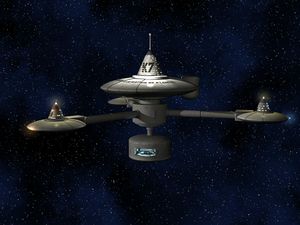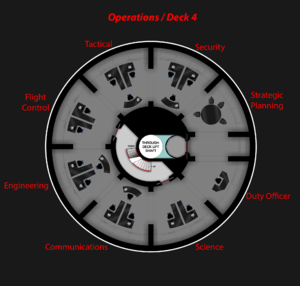
The Blazing Umbra Station is a Class K Space Station operated by Solas Tempus facility orbiting Shatten III in the Schatten Star System. The facility's location is kept largely secret from the general public, though it is not in an of itself classified. The star system it resides it makes it an excellent research and development facility, though recently the Action Arm of Solas Tempus due to the effects of subspace anomalies within the system with some surprising and largely unexplained effects.
Unique Modifications
A number of unique modifications to the basic designs have been made.
Operations

The stations central control center is Operations located on Deck 4, called Ops for short. Operations is in charge of managing all of the stations systems and resources and works similar to the bridge of a starship. Since the station is equipped with holographic projectors throughout, Ops uses holographic interfaces and control surfaces at every station to enhance the ability for any given station to manage their various tasks.
It is divided into 8 segments each with its own purpose. Clockwise from the Duty Officer's station:
- Science
- Communications
- Engineering
- Flight Control
- Tactical
- Security
- Strategic Planning
Duty Officer
The duty officer in operations is in charge of managing and allocating resources throughout the station, usually according to the guidelines and schedules provided by the department heads, executive officer, or the commanding officer. The duty officer is also in charge of coordinating between department heads and the command staff.
Strategic Planning
A small meeting area is also provided for planning purposes and short meetings with department heads and such to coordinate efforts. This is done in operations so they duty officer can stay within earshot of what's going on during busy times.
Flight Control
While the flight deck / shuttle bay has the primary task of launching and landing vessels, flight control authorizes flights and acts as a traffic controller for the space around the station.
Flight Deck
The flight deck's area has been expanded, knocking out the center divider between the two shuttle bays to provide a single large shuttle bay, the edges have also been widened by an additional 10 meters. This new shuttle bay measures 40 x 80 meters with bay doors on either side. The maintenance bay has been similarly expanded measuring 60 x 60 meters, and has been equipped with bay additional bay doors along one side of the bay, allowing direct access the maintenance bay. The two access lifts have been removed and replaced with a single 30 meters diameter circular lift. This allows the bay to handle 4 Danube Class Runabouts and 2 Type 9 Shuttle Craft.
Crew
Characters marked with a * are NPC's
Command Crew
- Commanding Officer
- Captain Sal D'Amico
- Executive Officer
- Lt. Commander Neo Akazuli
- Operations Officer
- Lt. Commander D'muk*
- Chief of Engineering
- Lt. Commander Angela Benton*
- Chief of Security
- Lieutenant Mike-07
- Chief Tactical Officer
- NCO : Argasun Qorchi
- Chief Medical Officer
- Doctor Aytise Alshat
- Lead Intelligence Officer
- Captain Lee Armstrong Finnegan
- Counselor
- NCO Cyro
Security Crew
- Lt. Junior Grade Fi (CT-51/54)
Engineering Crew
- Crewman 1st Class Matthew Gudavich
- Crewman 2nd Class Randy Baker*
Computer Specialists
- NCO Damien Smith
- NCO Elica Corwin
- NCO Mick Rodger
Combat Air Patrol
- Lt. Commander Neo Akazuli
- NCO Alema
- NCO Kitara Yasei
- Doctor Aytise Alshat
- NCO Unit 1247
- NCO Orn'Ornomee
Medical Staff
- NCO Flint Stone
- NCO Alyssa Aspen
Station Policy
This is not a comprehensive list of policies aboard the station, they are the most notable policies.
- Civility must be maintained, assaults, threats of violence, murder, and the like are prohibited.
- There shall be no violations of private property or privacy unless such has been authorized by the stations command personnel.
- Theft shall not be tolerated aboard the station and the stations command may press charges even if the victim does not wish to.
- Civilian weapons should be kept secure while not in use, either on ones person or within ones quarters / the station armory.
- Personnel using the station armory for weapons storage, will have access to the armory granted.
- The stations armory is not to be treated as a general use weapons locker, unless otherwise authorized no person may remove weapons or other gear from the armory unless it belongs specifically to them.
- At the discretion of the stations command, occupants of the station may be asked to relinquish their weapons.
- New occupants to the station whose background cannot be checked will be asked to temporarily relinquish their weapons.
- Weapons relinquished will be placed in the station armory, but not for public use but for storage and study.
- After weapons have been analyzed for capabilities and potential threats, they can be returned to their original owner.
- Orders of the enlisted personnel should be followed by the civilian population, complaints about such orders and directives should be directed either toward the department head of the station personnel involved or toward one of the command crew starting with the Operations Officer.
Power Source
The station's primary power system is a set of 4 compact Matter/Anti-Matter reactors which use high energy plasma to distribute energy throughout the station. The station has 2 auxiliary fusion reactors which can run the station in the event of an emergency.
Services
The station offers recreational and training facilities.
- Arboretum (Module B, Deck 27-29)
- Armory (Deck 21)
- Cargo Bays (Deck 17-22)
- Computer Core (Deck 18-22)
- Crew Quarters (Deck 6-7, 10-15, 19)
- Finnegan's Tavern (Deck 5)
- Flight Deck (Deck 32-39)
- Gyms (Deck 16)
- Holodecks (Deck 16)
- Hydroponics (Module B, Deck 21-26)
- Main Engineering (Deck 22-31)
- Operations (Deck 4)
- Promenade (Deck 16)
- Research & Development (Deck 18, Module C)
- Security (Deck 21)
- Sickbay (Deck 18)
- Stellar Cartography (Module A Deck 27-29)
- Temporal Operations (Module A Deck 21-25)
- Theatre / Stage (Deck 8)
- Workshops / Fabrication (Deck 19-21)
Transporter Rooms
Visitor Pads
Visitor pads are smaller transporter room with just two transporter pads each. Each is designated by a greek letter.
- Alpha / C.O. Office (Deck 9)
- Beta (Deck 6)
Group Pads
Group pads have 22 individual transporter pads in each room. Each is designated by a number.
Rooms in the primary hull:
- Room 1 (Deck 8)
- Room 2 (Deck 18)
- Room 3 (Deck 21)
- Room 4 (Deck 21)
- Room 5 (Deck 35)
Rooms in modules:
- Room 6 (Deck 26A)
- Room 7 (Deck 26B)
- Room 8 (Deck 26C)
Cargo Pads
Generally lower resolution sensors running at lower power. Not fit for transporting living matter in the default mode. Each is designated by the name C (or Charlie) and a number.
Rooms in the primary hull:
- Room C1 (Deck 20) - Cargo
- Room C2 (Deck 34) - Cargo
Rooms in modules:
- Room C3 (Deck 29A) - Cargo
- Room C4 (Deck 29B) - Cargo
- Room C5 (Deck 29C) - Cargo
Offices
- Guest Office (Admiral Lance Thomas) (Deck 7)
- Commanding Officer (Captain Sal D'Amico) (Deck 9)
- Executive Officer (Lt. Commander Neo Akazuli) (Deck 10)
- Chief Engineer (Deck 30)
- Chief Medical Officer (Deck 18)
- Chief Security Officer (Deck 21)
- Chief Science Officer (Deck 26C)
Specific Crew Quarters
- Admiral Lance Thomas Thomas (Deck 7)
- Captain Sal D'Amico (Deck 10)
- Death Korps Quarters (Deck 13)
Origins
The station's origin is largely unknown. Explorations by the USS Genesis found the station, completely intact, in the uninhabited star system. The systems anomalies make extremely difficult to travel too and from, so the station's existence was paradoxical. Further more, the station was already configured with an inactive, but completely functional, HAL 9000 hub. The power systems on the station were also completely depleted. Once restored the station's markings were of a Solas Tempus facility with the name of Blazing Umbra Station. The origin of this has long puzzled Solas Tempus officials and has been classified top secret by the Admiralty.
The final puzzle, however, is perhaps the largest. The HAL 9000 hub lists its installation date as over 1 billion years ago, which is quite frankly absurd. This was, however, confirmed by quantum signature dating of the station itself showing the station was in a temporal containment field for around that same amount of time which could very well be what drained the stations power systems as a field of that magnitude would be difficult to sustain for that long. Since the temporal containment field was in use during the time, more traditional means of data (carbon dating, potassium dating, or radiological analysis) are not available to use. These dating methods show that the station was released from its temporal field just a matter of days prior to the USS Genesis first discovering the station. Which would seem to indicate that power failed around that time.
Cover
The cover story that the station was purchased in pieces and assembled over the course over the course of 2 years before being brought online remains accepted and intact. Research into the stations past is restricted.